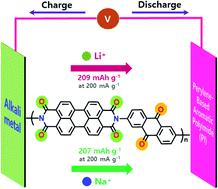当前位置:
X-MOL 学术
›
Sustain. Energy Fuels
›
论文详情
Our official English website, www.x-mol.net, welcomes your
feedback! (Note: you will need to create a separate account there.)
A perylene-based aromatic polyimide with multiple carbonyls enabling high-capacity and stable organic lithium and sodium ion batteries
Sustainable Energy & Fuels ( IF 5.0 ) Pub Date : 2020-10-29 , DOI: 10.1039/d0se01246g Michael Ruby Raj 1, 2, 3, 4, 5 , Nangyeong Kim 1, 2, 3, 4, 5 , Gibaek Lee 1, 2, 3, 4, 5
Sustainable Energy & Fuels ( IF 5.0 ) Pub Date : 2020-10-29 , DOI: 10.1039/d0se01246g Michael Ruby Raj 1, 2, 3, 4, 5 , Nangyeong Kim 1, 2, 3, 4, 5 , Gibaek Lee 1, 2, 3, 4, 5
Affiliation

|
Redox-active organic electrode materials are considered promising alternatives to inorganic intercalation analogs in organic metal-ion batteries. However, their poor cycling stability owing to high solubility in organic electrolytes and poor electronic conductivity remain a challenge for all-organic battery applications. Constructing new conjugated aromatic polyimides (PIs) or polymers with characteristics of improved electronic conductivity and abundant redox-active units (i.e., dual redox units containing multiple carbonyl groups) is an effective method of preventing these battery problems. In this study, we synthesized a perylene-3,4:9,10-tetracarboxylic dianhydride (perylene)-based aromatic PI as the cathode material, which is incorporated with two distinct types of redox-active units through the polymerization of perylene-3,4:9,10-tetracarboxylic acid with a 2,6-diaminoanthraquinone moiety, which has multiple redox-active carbonyl sites. The as-prepared PI exhibited significantly lower stability problems and enhanced the performance of electrochemical kinetics in both organic lithium and sodium ion batteries owing to improved electronic conductivity via a unique π-conjugation structure and the PI's multiple redox kinetics. The battery cells with the PI cathode exhibited initial discharge capacities of 209 mA h g−1 (for Li+/Li) and 207 mA h g−1 (for Na+/Na) at a high current rate of 200 mA g−1. The PI exhibited a better long-life cycling stability with a high-rate discharge ability (15 mA h g−1 for Li+/Li) with a capacity retention of 14%; and 78 mA h g−1 for Na+/Na with 54% capacity retention at a current density of 1C over 1000 cycles. These values are among the best when the delivered high specific capacities and stable cycle performance of both Li+/Na+ ion storage are compared with the previously reported similar PIs used for Li+-ion storage. This demonstrates the promising potential application of multiple redox-active units (i.e., dual redox-active units) in the design of sustainable cathodic materials for next-generation electrochemical energy storage devices.
中文翻译:

带有多个羰基的per基芳香族聚酰亚胺,可实现高容量且稳定的有机锂和钠离子电池
氧化还原活性有机电极材料被认为是有机金属离子电池中无机嵌入类似物的有前途的替代品。然而,由于在有机电解质中的高溶解度和差的电子传导性,它们的差的循环稳定性仍然是全有机电池应用的挑战。构造具有改善的电子电导率和丰富的氧化还原活性单元的新共轭芳族聚酰亚胺(PI)或聚合物(即,含有多个羰基的双氧化还原单元)是预防这些电池问题的有效方法。在这项研究中,我们合成了基于-3 3,4:9,10-四羧酸二酐(per)的芳族PI作为阴极材料,通过per 3的聚合将其与两种不同类型的氧化还原活性单元结合在一起具有2,6-二氨基蒽醌部分的,4:9,10-四羧酸,具有多个氧化还原活性羰基位。所制备的PI在有机锂和钠离子电池中均表现出明显较低的稳定性问题并增强了电化学动力学性能,这是由于通过独特的π共轭结构和PI的多重氧化还原动力学。具有PI阴极的电池单元在200mA g -1的高电流速率下表现出209 mA hg -1(对于Li + / Li)和207 mA hg -1(对于Na + / Na)的初始放电容量。PI表现出更好的长寿命循环稳定性,具有高倍率放电能力(Li + / Li为15 mA hg -1),容量保持率为14%;Na + / Na的电导率为78 mA hg -1,在1000次循环的1C电流密度下保持54%的容量。当锂离子电池具有较高的比容量和稳定的循环性能时,这些值是最佳值将+ / Na +离子存储与以前报道的用于Li +离子存储的类似PI进行比较。这证明了在设计用于下一代电化学储能装置的可持续阴极材料中,多个氧化还原活性单元(即双重氧化还原活性单元)的潜在应用前景。
更新日期:2020-12-17
中文翻译:

带有多个羰基的per基芳香族聚酰亚胺,可实现高容量且稳定的有机锂和钠离子电池
氧化还原活性有机电极材料被认为是有机金属离子电池中无机嵌入类似物的有前途的替代品。然而,由于在有机电解质中的高溶解度和差的电子传导性,它们的差的循环稳定性仍然是全有机电池应用的挑战。构造具有改善的电子电导率和丰富的氧化还原活性单元的新共轭芳族聚酰亚胺(PI)或聚合物(即,含有多个羰基的双氧化还原单元)是预防这些电池问题的有效方法。在这项研究中,我们合成了基于-3 3,4:9,10-四羧酸二酐(per)的芳族PI作为阴极材料,通过per 3的聚合将其与两种不同类型的氧化还原活性单元结合在一起具有2,6-二氨基蒽醌部分的,4:9,10-四羧酸,具有多个氧化还原活性羰基位。所制备的PI在有机锂和钠离子电池中均表现出明显较低的稳定性问题并增强了电化学动力学性能,这是由于通过独特的π共轭结构和PI的多重氧化还原动力学。具有PI阴极的电池单元在200mA g -1的高电流速率下表现出209 mA hg -1(对于Li + / Li)和207 mA hg -1(对于Na + / Na)的初始放电容量。PI表现出更好的长寿命循环稳定性,具有高倍率放电能力(Li + / Li为15 mA hg -1),容量保持率为14%;Na + / Na的电导率为78 mA hg -1,在1000次循环的1C电流密度下保持54%的容量。当锂离子电池具有较高的比容量和稳定的循环性能时,这些值是最佳值将+ / Na +离子存储与以前报道的用于Li +离子存储的类似PI进行比较。这证明了在设计用于下一代电化学储能装置的可持续阴极材料中,多个氧化还原活性单元(即双重氧化还原活性单元)的潜在应用前景。











































 京公网安备 11010802027423号
京公网安备 11010802027423号